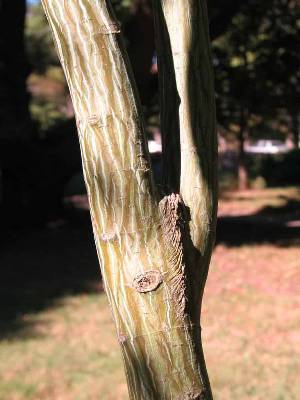Resource Library
Plant of the Week: Plant of the Week: Acer davidii Maple, Striped Bark Maple, Snakebark Maple, Moosewood
I have a collector’s instinct and whenever conditions conspire for me to look at a group of plants in side-by-side comparisons, I can’t resist the temptation. About five years ago I assembled a collection of about eight striped bark maples here at the Botanical Garden in northwest Arkansas. In this little mini-trial I learned a lot, most of it not good.
The striped bark maples are a small group of 15-20 species of understory maples found in cooler regions of the northern hemisphere. One species, Acer pensylvanicum, is native in North America and ranges from much of eastern Canada down to Georgia at high elevations in the Appalachian chain. The other species are native to northeastern China, Korea, Japan and eastern Siberia. Moosewood is a common name for these maples and is a good indicator of the kind of habitat where they are likely to be seen in numbers.
All striped bark maples are characterized as being low branched trees in the 30-foot-tall range, with vertically striped greenish bark that is lined with white, pink or red, depending on the species and the age of the trunk. Leaves are mostly three lobed and shaped a bit like a duck’s foot but in some species, such as Acer davidii, there is no lobeing while in a few leaves will be five lobed. Fall color tend to yellow to yellow-orange, and is quite good in older, established trees.
The flowers of the snake bark maples are relatively showy and tend to be strings of half inch diameter, five petaled chartreuse blooms in drooping clusters to 6 inches long that appear after the leaves have emerged. The seeds are the typical samaras of maples.
I know most of what I know about the striped bark maples from reading about them, not from studying the plants in my living collection. All but two of them died and only David’s striped bark maple seems to be really getting established and prospering.
The stressful heat and drought years of 2011 and 2012 were not good years to plant maples from the north woods of the northern hemisphere. And to make matters worse, I didn’t have enough shady locations to give them the summertime shade they need, so after two years most had simply curled up and died. While this is discouraging, it shows that unless there is a burning desire to collect there is no real reason to attempt growing these maples in the heat of the South.
Stripe barked maples could be used as small wintertime specimens near a patio or walkway. They are hardy from zones 4-7 and should only be planted where they get afternoon shade. They have poor drought and heat tolerance so careful attention to irrigation is a must.
For more information about horticulture or to see other Plant of the Week columns, visit Extension's Web site, www.uaex.uada.edu, or contact your county extension agent. The Cooperative Extension Service is part of the U of A Division of Agriculture.
Pursuant to 7 CFR § 15.3, the University of Arkansas System Division of Agriculture offers all its Extension and Research programs and services (including employment) without regard to race, color, sex, national origin, religion, age, disability, marital or veteran status, genetic information, sexual preference, pregnancy or any other legally protected status, and is an equal opportunity institution.
